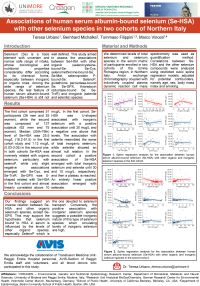Abstract
Introduction: Selenium (Se) is a trace element with uncertain and narrow safe range of intake, whose toxicological and nutritional properties considerably differ according to its chemical forms, especially between inorganic or organic ones. Among the wide range of selenium species, the real feature of human serum albumin-bound selenium (Se-HSA) is still not well defined. This study aimed to assess the associations between Se-HSA with other organic (selenocysteine-bound-Se: Se-Cys, selenomethionine-bound-Se: Se-Met, selenoprotein P-bound-Se: SelenoP, glutathione peroxidase-bound Se: Se-GPX, thioredoxin reductase-bound Se: Se-TrxR) and inorganic (selenite and selenite) species.
Material and methods: We determined levels of total selenium and selenium species in the serum matrix of participants enrolled in two cohorts of the Emilia Romagna region, in Northern Italy. Anion exchange chromatography coupled with inductively coupled plasma dynamic reaction cell mass spectrometry was used as quantification method. Correlations between Se-HSA and the other selenium compounds were analyzed using restricted cubic spline regression models, adjusted for potential confounders, namely age, sex, body mass index and smoking.
Results: The first cohort comprised 51 participants (26 men and 25 women), while the second was composed of 137 subjects (62 men and 75 women). Median (25th-75th) level of Se-HSA was 25.5 mcg/L (16.2-51.5) in the first cohort study and 1.12 mcg/L (0.03-3.05) in the second one. In both cohorts Se-HSA was inversely related with organic selenium, particularly with selenoP, while only slight negative associations emerged with Se-Cys, and Se-TrxR. Se-GPX was U-shaped related with Se-HSA in the first cohort and almost linearly correlated above 10 mcg/L. In the first cohort, Se-HSA was U-shaped associated with inorganic selenium with a positive association until 30 mcg/L and a negative one above that levels. The association with selenite resembled the same of total inorganic selenium, while selenite showed an almost null relation. In the second cohort a positive association of Se-HSA emerged with total inorganic selenium and selenite until 30 and 10 mcg/L, respectively, and then a plateau is reached. An entirely linear positive association emerged with selenate.
Conclusion: Our findings suggest an inverse relation between Se-HSA and other organic selenium species, except Se-GPX. This may support the hypothesis that selenium bound to HSA in serum is influenced by the levels of other organic species, especially SelenoP which is the one devoted to selenium transport. Conversely, the positive association with inorganic selenium species suggests a possible inorganic nature of this type of selenium species when circulating levels of inorganic selenium are high.

